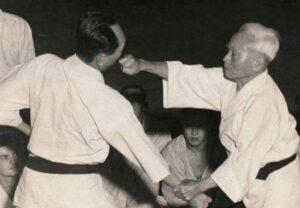To unleash the full force of a punch, it’s crucial for both arms to work in harmony, a principle frequently emphasized in the Dojo. One arm (the fist) is thrust forward, while the other arm is drawn back to the side of the body (Hikite). Both arms execute the same movement, meaning that if the right arm extends in a straight line, the left arm should retract in a straight line as well. Similarly, if the motion is circular to the right, it’s also circular to the left.
But!!! You might often hear that Hikite is primarily about generating powerful punches. However, this perspective doesn’t capture the full essence of Hikite. It extends beyond a simple hand movement pulled back to the side of the body for generating powerful punches.

When someone attacks you, it’s a natural reflex to raise your arms to defend yourself. This is where the Hikite function comes into play. Its primary role is to serve as a defensive block (a reflex action). If the opportunity arises, you can also utilize Hikite to grab your opponent’s arm or any available object and pull it back, demonstrating the practicality of Hikite. Meanwhile, the opposite arm, typically in a fist position, is geared toward launching an offensive counterattack.
Hikite serves a dual purpose, not limited to blocking and grabbing. It also functions as a means of controlling your opponent’s arm and movements.
Thanks for reading.
Gert
Share this article
